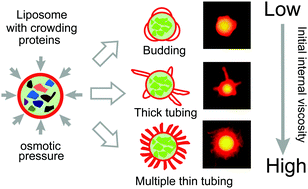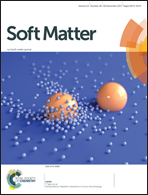Liposomal internal viscosity affects the fate of membrane deformation induced by hypertonic treatment
Abstract
Artificial lipid membranes have been utilized to understand the physical mechanisms of the deformation patterns of live cells. However, typical artificial membrane systems contain only dilute components compared to those in the cytoplasm of live cells. By using giant unilamellar liposomes containing dense protein solutions similar to those in live cells, we here reveal that viscosity derived from internal crowding affects the deformation patterns of lipid membranes. After hypertonic treatment, liposome deformation patterns transitioned from budding to tubing when the initial internal macromolecular concentrations were increased. Remarkably, instead of observing different transition concentrations between two species of macromolecules, the viscosity at the transition concentration was found to be similar. Further analyses clearly demonstrated that the internal viscosity affects the deformation patterns of lipid membranes induced by hypertonic treatment. These results indicate that the viscosity of the cytoplasm is a key factor in determining cell deformation, and suggest the association of a process involving dynamic instability, such as a viscous fingering phenomenon, during the determination of deformation patterns by hypertonic treatment.



 Please wait while we load your content...
Please wait while we load your content...